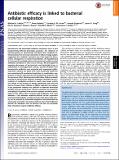Antibiotic efficacy is linked to bacterial cellular respiration
Author(s)
Belenky, Peter; Gutierrez, Arnaud; Schwarz, Eric G.; Dwyer, Daniel J.; Khalil, Ahmad S.; Collins, James J.; Porter, Caroline; Yang, Jason Hung-Ying; Lobritz, Michael Andrew; ... Show more Show less
DownloadLobritz-2015-Antibiotic efficacy.pdf (1.502Mb)
PUBLISHER_POLICY
Publisher Policy
Article is made available in accordance with the publisher's policy and may be subject to US copyright law. Please refer to the publisher's site for terms of use.
Terms of use
Metadata
Show full item recordAbstract
Bacteriostatic and bactericidal antibiotic treatments result in two fundamentally different phenotypic outcomes—the inhibition of bacterial growth or, alternatively, cell death. Most antibiotics inhibit processes that are major consumers of cellular energy output, suggesting that antibiotic treatment may have important downstream consequences on bacterial metabolism. We hypothesized that the specific metabolic effects of bacteriostatic and bactericidal antibiotics contribute to their overall efficacy. We leveraged the opposing phenotypes of bacteriostatic and bactericidal drugs in combination to investigate their activity. Growth inhibition from bacteriostatic antibiotics was associated with suppressed cellular respiration whereas cell death from most bactericidal antibiotics was associated with accelerated respiration. In combination, suppression of cellular respiration by the bacteriostatic antibiotic was the dominant effect, blocking bactericidal killing. Global metabolic profiling of bacteriostatic antibiotic treatment revealed that accumulation of metabolites involved in specific drug target activity was linked to the buildup of energy metabolites that feed the electron transport chain. Inhibition of cellular respiration by knockout of the cytochrome oxidases was sufficient to attenuate bactericidal lethality whereas acceleration of basal respiration by genetically uncoupling ATP synthesis from electron transport resulted in potentiation of the killing effect of bactericidal antibiotics. This work identifies a link between antibiotic-induced cellular respiration and bactericidal lethality and demonstrates that bactericidal activity can be arrested by attenuated respiration and potentiated by accelerated respiration. Our data collectively show that antibiotics perturb the metabolic state of bacteria and that the metabolic state of bacteria impacts antibiotic efficacy.
Date issued
2015-07Department
Massachusetts Institute of Technology. Institute for Medical Engineering & Science; Massachusetts Institute of Technology. Synthetic Biology Center; Harvard University--MIT Division of Health Sciences and Technology; Massachusetts Institute of Technology. Department of Biological EngineeringJournal
Proceedings of the National Academy of Sciences
Publisher
National Academy of Sciences (U.S.)
Citation
Lobritz, Michael A., Peter Belenky, Caroline B. M. Porter, Arnaud Gutierrez, Jason H. Yang, Eric G. Schwarz, Daniel J. Dwyer, Ahmad S. Khalil, and James J. Collins. “Antibiotic Efficacy Is Linked to Bacterial Cellular Respiration.” Proc Natl Acad Sci USA 112, no. 27 (June 22, 2015): 8173–8180.
Version: Final published version
ISSN
0027-8424
1091-6490